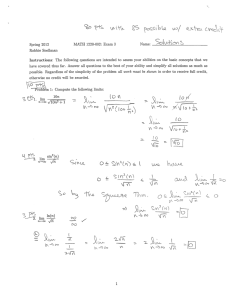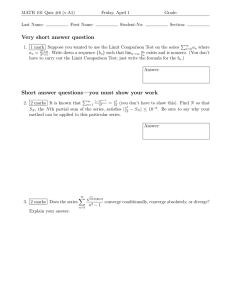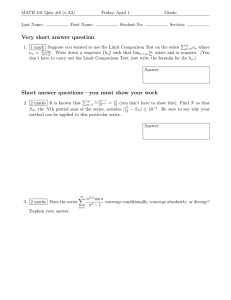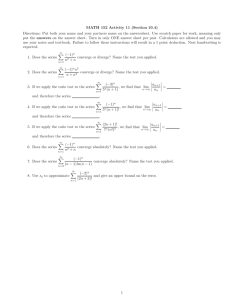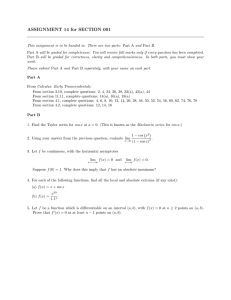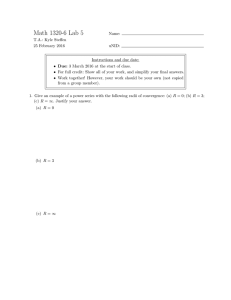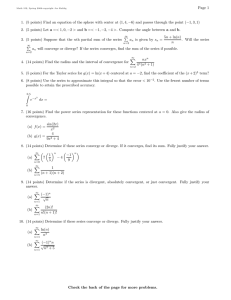Mathematics 1220 Exam II Review Fall 2006
advertisement
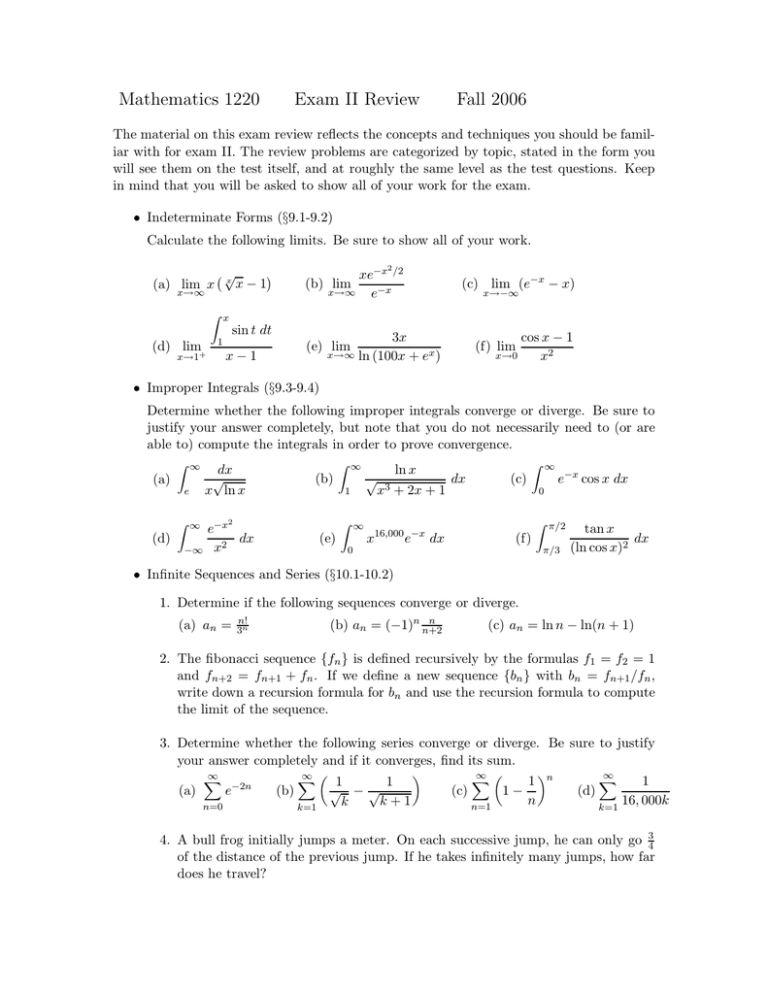
Mathematics 1220
Exam II Review
Fall 2006
The material on this exam review reflects the concepts and techniques you should be familiar with for exam II. The review problems are categorized by topic, stated in the form you
will see them on the test itself, and at roughly the same level as the test questions. Keep
in mind that you will be asked to show all of your work for the exam.
• Indeterminate Forms (§9.1-9.2)
Calculate the following limits. Be sure to show all of your work.
√
x
(a) lim x
x→∞
Z
2
xe−x /2
(b) lim
x→∞
e−x
x−1
x
sin t dt
1
(d) lim
x→1+
(e) lim
x−1
x→∞
(c) lim (e−x − x)
x→−∞
3x
ln (100x + ex )
(f) lim
x→0
cos x − 1
x2
• Improper Integrals (§9.3-9.4)
Determine whether the following improper integrals converge or diverge. Be sure to
justify your answer completely, but note that you do not necessarily need to (or are
able to) compute the integrals in order to prove convergence.
(a)
Z
∞
Z
∞
dx
√
x ln x
e
(d)
(b)
∞
Z
∞
1
2
−∞
Z
e−x
dx
x2
(e)
ln x
√
dx
3
x + 2x + 1
16,000 −x
x
e
(c)
Z
∞
e−x cos x dx
0
dx
(f)
Z
π/2
π/3
0
tan x
dx
(ln cos x)2
• Infinite Sequences and Series (§10.1-10.2)
1. Determine if the following sequences converge or diverge.
(a) an =
n!
3n
n
(b) an = (−1)n n+2
(c) an = ln n − ln(n + 1)
2. The fibonacci sequence {fn } is defined recursively by the formulas f1 = f2 = 1
and fn+2 = fn+1 + fn . If we define a new sequence {bn } with bn = fn+1 /fn ,
write down a recursion formula for bn and use the recursion formula to compute
the limit of the sequence.
3. Determine whether the following series converge or diverge. Be sure to justify
your answer completely and if it converges, find its sum.
(a)
∞
X
n=0
e
−2n
(b)
∞ X
1
k=1
1
√ −√
k+1
k
(c)
∞ X
n=1
1
1−
n
n
(d)
∞
X
1
16, 000k
k=1
4. A bull frog initially jumps a meter. On each successive jump, he can only go 34
of the distance of the previous jump. If he takes infinitely many jumps, how far
does he travel?
• Convergence of Infinite Series (§10.3-10.5)
Determine whether the following infinite series converge or diverge. Be sure to justify
your answers completely, but note you do not need to compute the sum. If the series
is not positive, you must state whether the convergence is absolute or conditional.
(a)
∞
X
n=1
(d)
∞
X
s
1
1 − cos
n
(−1)n+1
n=1
1
n2/3
(b)
∞
X
√
n=1
(e)
1
n sin
n
2n n!
(n + 2)!
n=1
∞
X
∞
X
1
n(ln
n)π
n=2
(c)
(f)
∞
X
(−1)n
n=2
n1/n
ln n
• Power Series, Taylor Series, Maclaurin Series (§10.6-10.8)
1. Find the convergence set for the following power series.
(a)
∞
X
n!(x + 1)n
n=0
3n
(b)
xn
n3 + 1
n=0
∞
X
(c)
∞
X
(−2)n+1 xn
n=0
(2n)!
2. Use power series operations and known power series to find power series representations for the following functions. Then, determine the interval of convergence
for the series.
Z x
1
tan−1 t
(a) f (x) =
(b)
f
(x)
=
dt
(c) f (x) = xe−x
(1 + x)2
t
0
3. Write the Maclaurin series for f (x) = sin x + cos x. for what values of x does it
represent f ?
4. Find the first five terms of the Taylor series for ex based at the point x = 2.
Solutions will be posted within the next few days.

